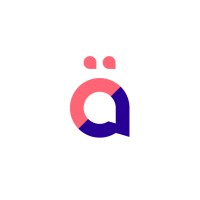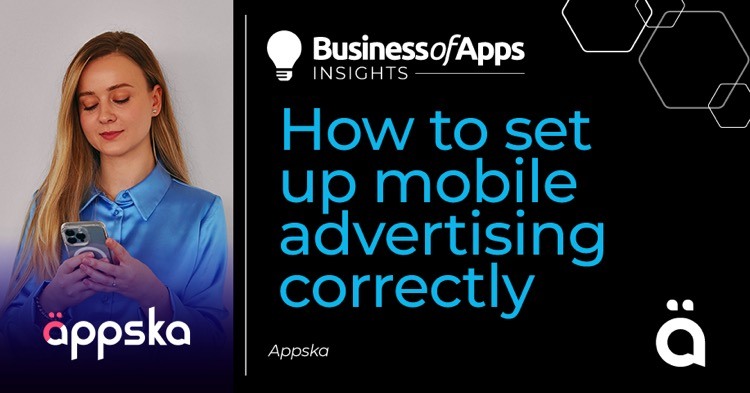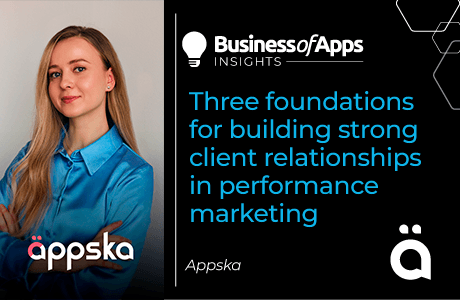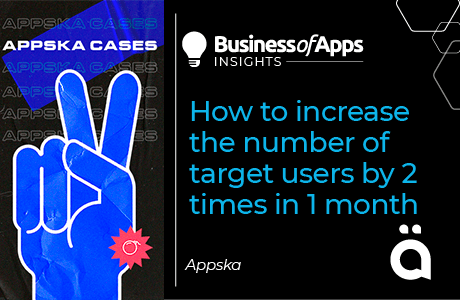Hello! My name is Nadia Katrich. I am the CEO of the international full-service performance marketing agency Appska. For 6 years of work, we have helped 100+ advertisers generate over 1,000,000+ events. And now I want to share a few tips that help us launch successful ad campaigns and get the most out of mobile advertising.
Catch and use! Let’s go!!!
Google Ads campaigns
When we launch campaigns in Google Ads, we separate the search and display networks into different campaigns because they have different target audiences and goals. Search network campaigns target users who are actively searching for specific products or services, while display network campaigns reach users while they are browsing the web. This method allows us to set up a more effective strategy and targeting, improving the results of the campaign as a whole.
In addition, we make as many versions of titles, descriptions, images, and videos as possible (at least 5). It is necessary for campaigns to learn and optimize because they have automatic targeting.
5 Reasons why you should separate search and display network campaigns:
- Objectives. Search network campaigns are optimized for performance-driven objectives, such as sales or leads, while display network campaigns are optimized for brand awareness and engagement.
- Audiences. Search network campaigns target users who are actively searching for specific products or services, while display network campaigns reach users while they are browsing the web.
- Ad Formats. Search network campaigns use text-based ads, while display network campaigns use visual ads such as banners and display ads.
- Targeting. Search network campaigns use keywords to target users, while display network campaigns use interests, demographics, and placements to reach users.
- Cost Models. Search network campaigns use a pay-per-click cost model, while display network campaigns use a cost-per-impression cost model.
By dividing search network and display network campaigns, advertisers can better target their desired audience, optimize for their specific objectives, and use the most effective ad formats and targeting options for each campaign.
Facebook Ads campaigns
The formula for a successful Facebook campaign is SDK + at least 10 versions of creatives, titles, and descriptions.
SDK is an important element for Facebook app promotion campaigns because it provides developers with tools to integrate Facebook functionality with their app.
Measurement and Analytics
SDK integrates with Facebook Analytics, allowing advertisers to track key metrics such as installs, in-app purchases, and user engagement.
Targeting
SDK provides access to Facebook’s audience targeting capabilities, including demographic, interest-based, and behavioral targeting.
User Experience
SDK enables deep linking, which allows users to be redirected to specific content within an app after installation.
Cost Savings
SDK integration enables cost-effective app install campaigns by automating the bidding process and reducing manual ad management efforts.
User Retention
SDK provides access to Facebook’s app event optimization, which optimizes ad delivery to users who are most likely to perform in-app actions.
Optimization
SDK provides the ability to optimize campaigns based on performance metrics, such as cost per install and return on ad spend.
Better Integration
SDK enables seamless integration with Facebook’s ad platform, making it easier for advertisers to manage campaigns and track results.
Thus, campaigns will receive data on events within applications and will therefore work most effectively to optimize for a particular event. And a large number of creatives will allow the algorithm to choose the best combination to achieve KPIs.
In addition, the minimum number of events for training is 1000. After that, the campaign will begin to bring results.
Why in-app network DSP is better than a single network
Advantages
- Broader Inventory
In-App network DSP provides access to a wider pool of in-app inventory from multiple sources, allowing advertisers to reach a larger audience.
- Targeting
In-App network DSP provides more advanced targeting options, such as audience segmentation and retargeting, compared to a single network.
- Efficiency
In-App network DSP enables real-time bidding and programmatic advertising, which can lead to more efficient ad spend and better ad performance.
- Cross-device Capabilities
In-App network DSP enables cross-device targeting and measurement, allowing advertisers to reach users across multiple devices.
- Data Integration
In-App network DSP enables the integration of first-party and third-party data, which can improve the accuracy of targeting and measurement.
- Cost Savings
In-App network DSP can provide cost savings by leveraging programmatic buying and reducing the need for manual negotiations with individual networks.
In addition, machine learning works for in-app DSP (Demand-Side Platform) by using algorithms to analyze data and optimize ad performance in real time.
Here is how it works:
Data Collection
In-app DSP collects data from various sources, such as user behavior, ad performance, and demographic information.
Data Analysis
Machine learning algorithms analyze the data to identify patterns and trends, such as which ad formats are most effective and which users are most likely to convert.
Predictive Modeling
The algorithms use the data to build predictive models that estimate future outcomes based on past performance.
Real-time Optimization
Based on the predictions, the in-app DSP optimizes ad delivery in real-time to maximize the performance of each campaign.
Continuous Learning
The machine learning algorithms continually learn from new data and adjust the predictive models to improve performance over time.
By using machine learning, in-app DSP can automatically and dynamically optimize ad delivery to improve campaign performance and drive better results for advertisers.
Multiple creatives & videos
When we run a campaign in the In-App network DSP, we use up to 15 versions of creatives. It will take 5-10 days and at least 100 events per day within the app to train the campaign. This will help the algorithm get the necessary data to buy traffic with a relevant audience.
Using multiple creatives and videos is important for app install campaigns in DSP (Demand-Side Platform) because of it:
Increases Reach
Multiple creatives and videos enable advertisers to reach a wider audience by appealing to different preferences and interests.
Improves Relevance
Different creatives and videos can target different audience segments, resulting in more relevant and personalized ad experiences.
Increases Engagement
Different creatives and videos can capture the attention of users in unique ways, increasing the likelihood of engagement and conversion.
Optimization
Testing multiple creatives and videos allows advertisers to determine which ones perform best, and optimize their campaigns accordingly.
A/B Testing
Running multiple creatives and videos enables advertisers to perform A/B testing to determine which ones drive the best results, and use those to maximize the performance of their campaigns.
By using multiple creatives and videos, machine learning algorithms in DSPs have more data to work with, which results in improved predictive modeling, enhanced optimization, and a better understanding of the target audience.
Conclusion
At Appska, we always follow these recommendations, and it brings us excellent results. We have already launched hundreds of successful advertising campaigns for our partners. If you are looking for the most successful promotion of your product, contact Appska right now!












